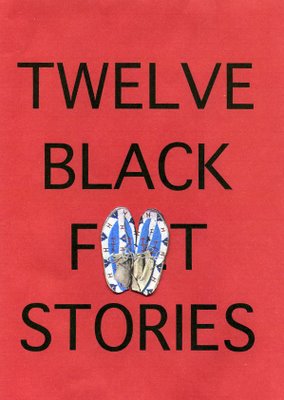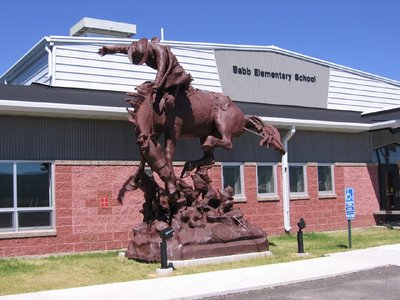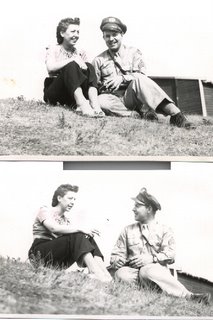No one ever pretended the CM Russell Auction was about anything but money. When in the Sixties the Great Falls Ad Club invented the auction, they frankly intended to make money to benefit the CM Russell Museum in Great Falls -- period. The auction has fulfilled that goal with such effectiveness that sometimes onlookers lose focus.
Let’s look at the money:
THURSDAY FIXED-PRICE SALE TOTAL: (This was a new feature and was held at the C.M. Russell Museum.) $275,000 TOTAL
Most expensive: Russell Chatham’s “
Rain Sweeping Over the Sweet Grass Basin.” $140,000
74 living artists participated and the works will remain on sale until March 31.
FRIDAY AUCTION TOTAL: $750,000. (Last year same night was $753,000.
C.M. Russell’s “
Indian Portrait” (10 by 8 inch watercolor) valued at $55,000 to $65,000 sold for $45,000.
Clyde Aspevig’s “
Winter Glow” (“big” oil) estimated at $50,000 to $70,000 sold for $32.500
O.C. Seltzer’s “
Blackfoot Scout” (16 by 17 inch watercolor) valued at $30,000 to $45,000 went for $35,000
E.S. Paxson “
The Aspen Fireplace Screen” (51 by 48 oil) valued at $20,000 to $25,000 went for $32,500
Chuck Fulcher “
Under a Yellow Canopy” (oil) valued at $2,000 to $3,000 went for $2500. (The painting won the Tuffy Berg Award for best new artist. Fulcher works for Lodestone Advertising in Great Falls.)
Three lots failed to meet their minimum and were withdrawn.
Saturday night’s totals haven’t been given yet, or maybe I missed them. The keystone to that night was two letters written and illustrated by Russell and sent to Robert Benn, proprietor of the bar in Kalispell’s Montana Hotel. One was written August 15, 1908, and the other July 22, 1910. Benn was murdered on March 27, 1915. It was rough in them days. (I can’t resist saying that Bob Scriver was born August 15, 1914.) One letter sold for $70,000 and the other for $69,000. I doubt anyone could tell you the reason for the $1,000 difference.
There were two sets of “
QUICK DRAW.” This year there was no model and the artists had a whole hour to work, rather than 45 minutes. They painted “out of their heads” or from photos. The first go-round added up to $28,000 for the work of twelve artists, almost double last year’s Friday quick draw ($14,850). Together the two go-rounds raised $52,750. (Last year the total was $55,550.) There was only one sculpture in each event. Gerald Balciar’s “
Eagle Rock” went for $10,000. (One assumes the clay will be translated into something else, like bronze.) The most unusual painting was in French dye on silk, “
Catch & No Release” by Nancy Dunlop Gawdrey, which sold for $5,000.
Aside from the Russell main action auction, there are a number of parallel gallery and association events. At the Great Falls Native American Art Show in the Civic Center, the event was swept by Blackfeet. Lyle Omeaso and Terrance Guardipee won juror’s choice. Honorable mentions went to David Dragonfly, Gale Running Wolf Sr, Kodi Kuka and King Kuka. In the miniature program the juror’s choice went to David Dragonfly and Robert Orduno, Honorable mention to Howard Pepion, Francis Wall, Valentina LaPier, Khol Kuka and King Kuka. These were not purchase prices and there is no mention of sales.
One of the most interesting stories was the fate of a fake Russell that showed up in last year’s auction. Paul Masa of Kalispell said he burned it “under the personal supervision of Ginger Renner.” B. Byron Price claims there were only two of these paintings of “
Black Eagle” whom Russell knew from the winter of 1888-1889. I suspect that a search of negatives would come up with the photo Russell used for reference. If someone discovers irrefutable proof that Russell painted the “fake” after all, there will be wailing. He DID sometimes paint the same subject twice or even more. That’s not unusual.
Another interesting development is that the Russell Auction, which has in the past been “local” and “Western” has begun to open out to other representative art. In fact, the “best of show” was to Calvin Liang for “
Newport Sailboats.” (One assumes that was Newport, Washington.) I think this is the trend most likely to change the face of the auction, so that it will be more like the Western Rendezvous show in Helena. In fact, I suspect that the genre of “Western art” may be in the process of losing its boundaries into the larger world of realistic art, esp. when it comes to landscapes and still lifes.
One exhibitor at the Heritage Inn kept a tally of visitors to his room and found that last year he had close to 2,500 visitors but this year he counted more like a thousand. I had a sense that there were fewer exhibitors in fewer rooms, but thought it was because I went on Thursday rather than Saturday. A major snowstorm came through late in the auction, which confused the issue. Did people stay away because the weather was so good just before the snow, or did they come when the snow began? Many exhibitors stayed over until the roads were safer.
It seemed to me that might be less enthusiasm on the part of motel management now that Al Donohue, one of the heavyweight Ad Club personalities, is deceased. The effort and wear-and-tear are enormous. The motel itself is aging, though it’s well-maintained.
In the case of the usually overrun Manitou Galleries auction at the Townhouse Motel, the action was clearly diminished. (There weren’t even many gamblers in Lucky Lil’s.) Nelson has sold the auction (but not his galleries) to Best of the West so the great quantity of assorted stuff he normally provided was not there. A modest show in the basement was more convenient, but less exciting.
One exhibitor said it was just much easier to sell art on the Internet. When I suggested that complications were arising with artists becoming reluctant to post photos of their works online (because of copying), they reported they hadn’t felt the effects yet.
Much of the reported material was about the big-time buyers, who appear to be treating the auction like a sporting event. They come in a group in a corporate jet, usually organized by someone who has become a Western art enthusiast, and each buy a dozen or so works, calling them “an expensive hobby” or “an addiction.” For them, being there is at least part of the point and it’s a chance to see the West, dress up in Western clothes and so on. In short, play “
Dallas.” There were a few shadowy figures who bought big-ticket art (like the Chatham) and remained anonymous. People generally suspected the media figures who have ranches in the state. But who knows? Might have been Japanese millionaires or German aficionadoes.
The Scriver bronzes were mostly the usual late and small pieces that circulate constantly through the auctions. In general, I thought the bronzes being shown were all high quality, and so was the painting. I’m always bemused by the monumental sculptures that show up on low-boys and are parked as close to the doors as they can get. This year there were fewer realistic horses and more wild welded Indian figures with a lot of action and whipping cables in them. Often skillful and striking! Something to put by the gate of your McMansion in a wheat field. (There weren't any of those in the Sixties when this auction first started.)








